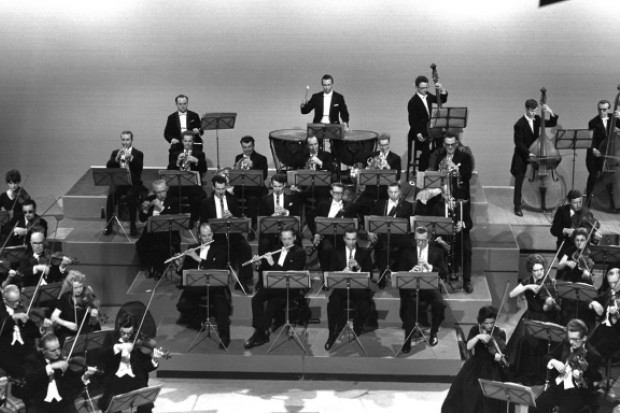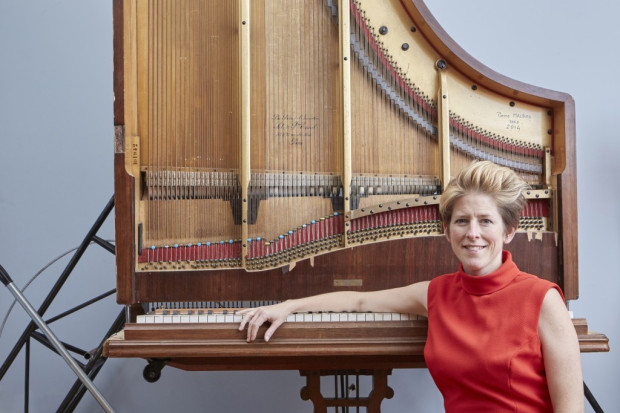
The Goldner Quartet from Australia performing in the Emily Anderson Concert Hall in NUI Galway.
Australian Gifts
The Goldner Quartet, formed in 1995, is named after musician and entrepreneur Richard Goldner, the man who founded the concert promoter Musica Viva Australia. Artistic Director of Music for Galway, Finghin Collins, was determined to bring the Goldner to Galway to be a part of the 38th concert season.
‘I met and played with them in Australia two summers ago,’ he said in September, ‘and thought I really want to bring them to Ireland. They’ve never played in Ireland. They are Australia’s finest quartet.’
A gift from their continent
The quartet, at the Emily Anderson Concert Hall in NUI Galway on 29 November, adopted a different layout to what I’m used to seeing. The violist sat on the far right with the cellist in the mid-right position. I noticed a difference in balance with this structure. For one, the viola sound was projected away from the audience. This created a warmer, rounded tone which blended the harmonies superbly but sacrificed bow definition. This set-up also gave more emphasis to the cello parts.
The award-winning quartet commenced their Irish debut with a gift from their continent: Quartet No. 11, ‘Jabiru Dreaming’, composed by Peter Sculthorpe (1929–2014). This contemporary work pays tribute to the Australian landscape and its indigenous people.
Sculthorpe specifically finds his inspiration from the music of the Kakadu National Park. The first movement is rife with Aboriginal rhythmic patterns. Sculthorpe explained in his concert note that some of these rhythms also suggest the gait of the Jabiru bird, a species of stork, which first violinist, Dene Olding, describes as ‘looking as if the stork is walking backwards although it is moving forward’. A cold sonic palette is created in this movement with Sculthorpe’s use of col legno battuto, harmonics and vibrato, or lack thereof. This creates a glassy texture throughout.
The second movement starkly contrasts with the first, both in texture, tonality and sentiment. It is more tune focused rather than rhythm oriented. The central motivic material is an Aboriginal chant believed to be the first ever committed to Western notation, transcribed by a member of the Baudin expedition in 1802. The chant is recited in its original form on solo cello at the beginning and then developed and explored as the movement continues. Sculthorpe certainly captures the essence of the chant and retains its character throughout. This movement embodies a much warmer sound, by means of joyful melodies, ample vibrato, cello depth and strong accompaniment.
Both movements, although vastly different, are linked by a single, distinguishing feature, a trademark of Sculthorpe’s, that of rapidly cascading harmonic glissandi. The effect creates an interesting sonic texture which, to me, emulates bird calls.
Skill and control
Shostakovich’s Quartet No. 9 in E-Flat, Op. 117, and Schubert’s Quartet in D minor, D810, ‘Death and the Maiden’, followed in the programme.
The Shostakovich piece is full of contrast, energy, counterpoint and interlocking motifs. It was well programmed in showing off the group’s interaction and versatility. The composer utilises many interesting techniques that require a lot of skill and control to execute; most notably, the strummed chords in the fourth movement. Intonation can be hard to control in this instance, especially at the rate of chord change, but there was no pitch out of place. During the gallop section, in the third movement, instead of a staccato articulation, first violinist Olding performed it spiccato which gave it a crisper, lighter sound. I preferred this variation.
The 23 years of performing together equipped the Goldner quartet with a particular advantage in playing the Schubert piece. It is an iconic work in the chamber music repertoire and distinguished by its driving triplet momentum and dramatic shifts in dynamic. Consistency is possibly the most difficult aspect of performing it, and the Goldner Quartet were air-tight.
Overall, it was a very pleasant concert and an excellent programme – the Goldner received a standing ovation. I look forward to listening to this quartet again.
Music for Galway’s next event is Handel’s Messiah with the Irish Baroque Orchestra on 8 December, followed by the annual Midwinter Festival on 18–20 January, featuring ConTempo quartet, Ailish Tynan, Henk Neven, Finghin Collins, Leon McCawley and Michael Collins. For more, visit http://www.musicforgalway.ie
Published on 7 December 2018
Jake Morgan is a composer and conductor from Galway who specialises in music and audio for film, theatre and video games. He studied contemporary composition and sound design at the Royal Irish Academy of Music and Windmill Lane Studios, and recently completed a Master's degree in Composition for Screen at the University of Edinburgh. Jake took part in the Journal of Music/Galway City Council Music Writer Mentoring Scheme in 2017/18.

















